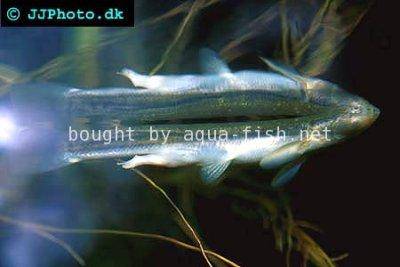Largescale foureyes - Anableps anableps
Scientific name: Anableps anableps
Common name: Largescale foureyes
Family: Anablepidae
Usual size in fish tanks: 26 - 30 cm (10.24 - 11.81 inch)
014
Recommended pH range: 7 - 8.1
Recommended water hardness: 9 - 24°N (160.71 - 428.57ppm)
0°C 32°F30°C 86°F
Recommended temperature range: 23 - 28 °C (73.4 - 82.4°F)
The way how these fish reproduce: Pseudo-Livebearer
Where the species comes from: South America
Temperament to its own species: peaceful
Temperament toward other fish species: aggressive to smaller
Usual place in the tank: Top levels
Food and Feeding
Largescale Foureyes (Anableps anableps) have a voracious appetite and require a high-protein diet to thrive. They primarily prefer surface feeding, where they can consume a variety of insects like fruit flies, brine shrimp, and tubifex worms. However, they are also flexible enough to accept other protein-rich foods such as shrimp, mussels, and even small pieces of beef heart. While they are surface feeders by nature, they can adapt to feeding from the substrate if necessary. To ensure a balanced diet, occasionally supplement their meals with quality flake food or pellets. This variety helps to provide the necessary nutrients for their health and longevity.
Origin
The Largescale Foureyes are native to South and Central America. They are typically found in coastal and brackish water environments, often near river mouths where freshwater meets the ocean. These unique habitats allow them to thrive in varying salinity levels, contributing to their adaptability in both freshwater and brackish aquariums.
Sexing
Sexual dimorphism in Largescale Foureyes is relatively apparent. Males have a modified anal fin known as a gonopodium, which they use for internal fertilization. The gonopodium can only swing to one side, making the mating process unique. Females lack this specialized fin and have a more rounded body shape, especially when carrying young.
Breeding
Breeding Largescale Foureyes is an interesting process due to their unique reproductive biology. These fish are livebearers, meaning they give birth to free-swimming young rather than laying eggs. Mating involves internal insemination, where the male uses his gonopodium to transfer sperm to the female. However, this process is unusual because the male's gonopodium can only swing in one direction. This means that the female must approach the male on the correct side for successful mating. Once fertilized, the female carries the developing young until they are ready to be born. The fry are relatively large at birth and are capable of accepting crushed flake food or newly hatched brine shrimp immediately.
Lifespan
The expected lifespan for Largescale Foureyes in captivity is around 6 years. Proper care, including a high-protein diet and a well-maintained environment, can help ensure they live a healthy life span. Their unique eye structure and feeding habits make them fascinating long-term residents of the aquarium.
Short Description
Largescale Foureyes are known for their most distinctive feature - their split eyes. Each eye is divided into two sections by a horizontal band of tissue, allowing them to simultaneously see both above and below the water surface. This adaptation enables them to spot potential predators and prey in both environments. They have a peaceful temperament and are best kept in a spacious tank that replicates their natural habitat, including brackish water conditions and gentle water flow.
Tank Setup
To provide an optimal environment for Largescale Foureyes, a spacious tank with plenty of surface area is recommended. A minimum of 100 liters (26 gallons) is advisable, although a larger tank is always better. Since they are surface dwellers, they require plenty of open water at the top of the tank. Adding some floating plants can help create a more natural environment and reduce their stress levels. These fish can thrive in both freshwater and slightly brackish conditions, so a small amount of marine salt can be added to the water to replicate their natural habitat.
Tankmates
Largescale Foureyes have a peaceful nature and can be kept with other non-aggressive species. Ideal tankmates include other peaceful brackish water fish like mollies and some gobies. Avoid keeping them with aggressive or fin-nipping species, as the Largescale Foureyes' calm demeanor makes them vulnerable to bullying. It's also best to keep them in small groups, as they are social and feel more secure when in the company of their own kind.
Pictures
Bought by aqua-fish.net from jjphoto.dk.








